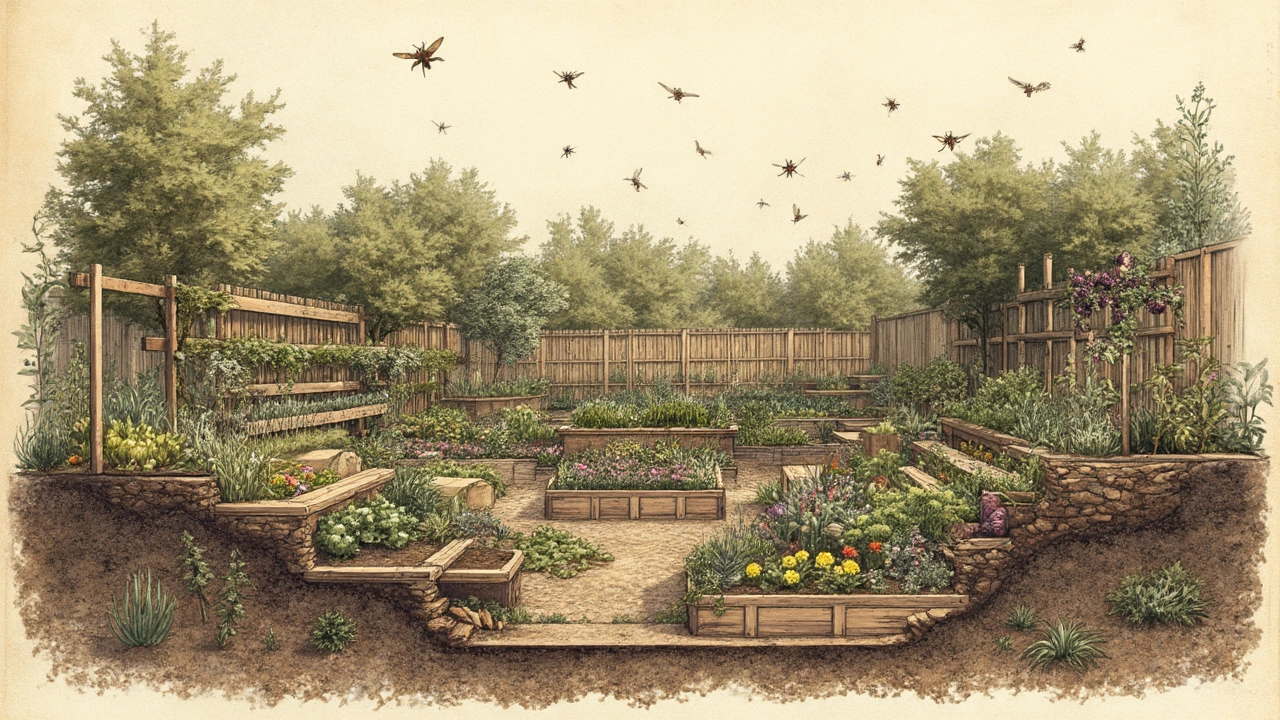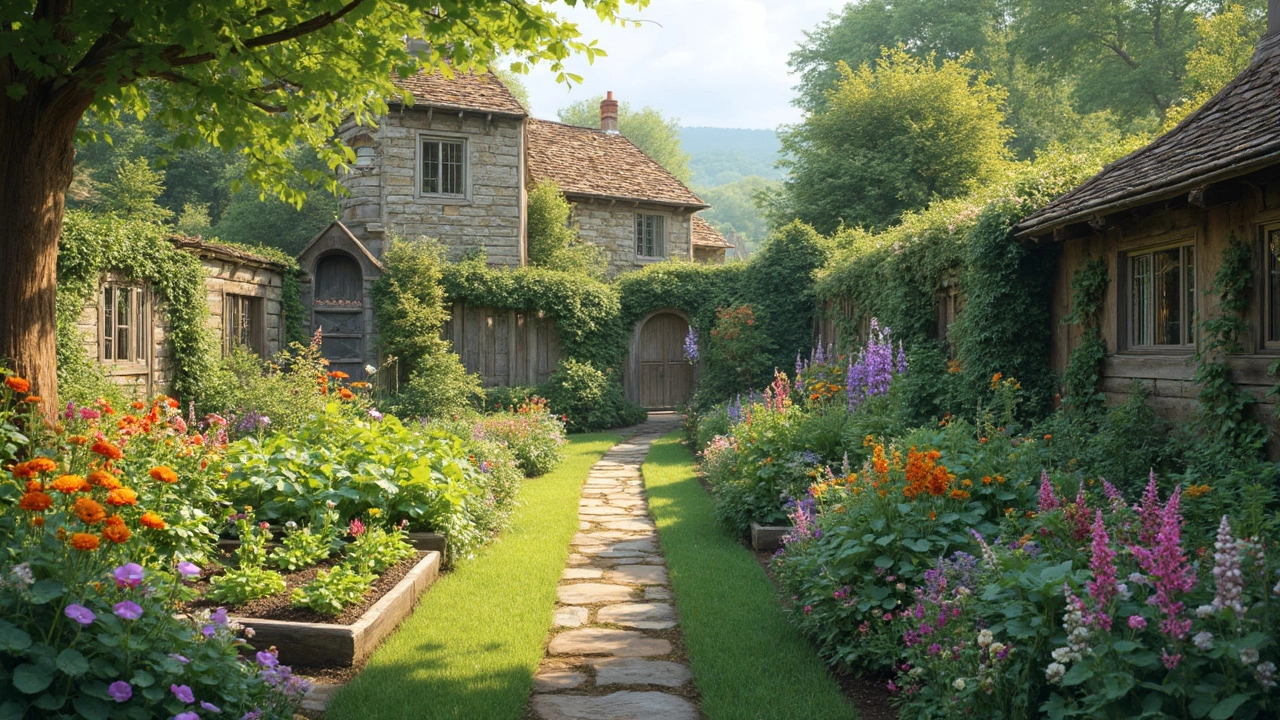Thinking about transforming your messy backyard into a lush garden paradise? It all starts with good organization. Honestly, below all the beauty of a great garden lies some clever planning. By being smart with your garden design, you not only make things look neat but also boost productivity.
First up, consider how you use your outdoor space. It's not just about flowers! Think veggies, herbs, and maybe even a fruit tree. This is why planning your garden layout is crucial. A well-laid plan saves time, effort, and yes, even money. List down what you want to grow and sketch a simple layout that gets everything more sunlight, better water flow, or whatever specific needs your plants have.
Now, let's get creative with the idea of vertical gardening. If you're short on space, this is your best pal. Climbing plants, hanging pots, and tiered shelving do wonders. You'll be surprised at how much more you can grow upwards without hogging precious ground. Plus, it adds a whole different dimension to your garden's aesthetic.
- Planning Your Garden Layout
- Utilizing Vertical Space
- Understanding Soil and Its Role
- Choosing the Right Plants
- Crop Rotation and Companion Planting
Planning Your Garden Layout
Crafting a functional and beautiful garden starts with some solid planning. Let's break it down so you can create a space that's both pretty and practical.
Define Purpose and Space
Before you start digging, think about what you want from your garden. Is it all about fresh veggies, a colorful oasis, or a bit of both? Knowing your goals helps you map out the space effectively. Measure your outdoor area and sketch a rough layout. Seeing it on paper makes a big difference.
Sunlight and Water Access
Plants need the right amount of sunlight, which can make or break your garden design. Observe your plot for a few days to spot the sunniest and shadiest spots. Pathways for water access are vital too. You don’t want to drag a heavy hose across your delicate blooms every day, right?
Efficient Movement
Design your layout so you can easily move through the garden without stepping over plants. Pebble or wooden pathways not only look good but also protect plant roots. Wide paths of about 18 inches are ideal for easy movement.
Group Plants by Needs
Keep plants with similar water and sunlight needs together. It saves you from watering some areas too much or too little. Group them so you can cater to each plant's preference without hassle.
Plan for Future Growth
Remember, plants grow. Give them room to sprawl without fighting for space as they mature. Factor in the height and width they'll reach when fully grown. Believe me, dealing with an overcrowded garden later is a headache.
Incorporate Zones
If you've got a larger space, think about creating zones. A veggie patch here, a reading nook there—it's like designing rooms in your home. Zones also make maintenance easier as you focus on one area at a time.
| Element | Consideration |
|---|---|
| Pathway Width | 18 inches minimum |
| Common Zones | Veggie Patch, Relaxation Area, Flower Beds |
| Sunlight Needs | 6 hours daily for vegetables |
So there you have it! With these tips, your garden design will not only look good but function like a dream. Every bit of planning pays off when you're harvesting fresh veggies or simply enjoying a peaceful corner.
Utilizing Vertical Space
When it comes to making the most of your garden, look up! Taking your plants vertical doesn't just save ground space—it can significantly increase your garden's productivity. This approach is a game-changer, especially for urban dwellers with limited yard room. So, let's dive into how you can transform a humble corner into a plant haven.
Vertical Gardening Basics
Think of your garden as a three-dimensional canvas. Vertical gardening is all about bringing plants off the ground. The simplest method? Climbing plants. Veggies like peas, cucumbers, and beans love to climb, and installing a trellis can guide them upwards instead of outwards. Got a wall? Attach sturdy brackets and shelves to accommodate lightweight pots and containers. Now, you’re not only saving space but also adding texture and depth to your garden design.
The Magic of Hanging Gardens
Who said gardens have to be rooted in the ground? Hanging gardens are versatile and chic. Install hooks along your fence or patio to suspend pots at varying heights. This is perfect for herbs and small flowers. Bonus—it makes them easy to harvest! Be sure to choose the right containers; lightweight options like coconut coir baskets work well and have excellent drainage.
Pal up with Pallets
Old pallets have loads of life left in them, especially in a vertical garden. Prop one against a wall, fill the gaps with soil, and plant away. It’s DIY-friendly and sustainable. Use this setup to grow salad greens or herbs.
Choosing the Right Plants
Not all plants are made for vertical life, so it’s wise to choose carefully. Climbers like tomatoes and certain beans are great for garden walls or trellises. For a hanging setup, think of strawberries, herbs, or even succulents. Observe the sunlight patterns to ensure each plant gets its preferred sun exposure.
Watering and Maintenance
A common concern with vertical gardens is watering. Trust me, it's easy to manage. Drip irrigation systems are an efficient way to water from the top down, ensuring every tier receives moisture. For hanging planters, consider self-watering pots to keep things simple.
Ultimately, harnessing vertical space isn’t just about cramming in more plants. It’s about using creativity and innovation to make your garden design work smarter for you. Incorporating these methods can turn gardening into a breeze instead of a chore.

Understanding Soil and Its Role
Let's dive right into the heart of gardening—soil. You know, it's not just dirt. It's the life support system for your plants, and understanding it can make or break your garden design.
Firstly, there are different kinds of soil, and identifying what you've got in your backyard is step one. Typically, soil is classified into three types: sandy, clay, and loamy. Each has its own quirks. For instance, sandy soil drains well but doesn't hold nutrients, whereas clay is nutrient-rich but can get waterlogged.
Testing Your Soil
Before planting anything, hit up your local garden center and grab a soil test kit. This nifty tool tells you the pH level of your soil (that’s how acidic or alkaline it is). Most garden plants love a slightly acidic environment, around pH 6 to 7. If it's out of whack, you might need amendments like lime to raise pH or sulfur to lower it.
Feeding the Soil
Think of your soil as a living organism. Feeding it with organic matter like compost not only enriches it with nutrients but also improves its texture and water retention. Just start a compost bin in the corner of your yard—it's a fantastic way to recycle kitchen scraps and yard waste.
For those serious about maximizing space in their garden layout, raised beds can be a great choice. They warm up faster in spring, meaning you can get growing sooner. They also offer better drainage, which is a win if you've got heavy clay soil.
Soil Health Stats
| Soil Type | Drainage Rate | pH Range |
|---|---|---|
| Sandy | Fast | 5.5 - 6.5 |
| Clay | Slow | 6 - 7 |
| Loamy | Moderate | 6 - 7 |
With this newfound knowledge, you can give your garden a solid foundation to flourish. Once you've nailed the soil, everything else just falls into place, and soon, you'll have a thriving garden, fresh veggies, and stunning flowers all season long.
Choosing the Right Plants
Picking the right plants for your garden can make or break your outdoor oasis. It’s kind of like setting the playlist for a party—you need the right vibe to match the setting. So, how do you decide what to plant?
Think About Your Climate
First things first, give a thought to your local climate. Are you dealing with freezing winters or blazing hot summers? Different *plants* thrive in different conditions. If you're in a cooler climate, think of plants like kale and spinach that can handle the chill. Meanwhile, basil and tomatoes love the heat of sunnier places.
Evaluate Your Space
Size matters—especially in urban gardens. If space is tight, go for compact or dwarf varieties of plants. Herbs like thyme and sage are great for small spaces and pack tons of flavor in salads and dishes.
Sun and Shade
Plants can be divas when it comes to sunlight. Some, like sunflowers and lavender, soak it up all day, while others, like hostas, prefer the shade. Keep an eye on your garden throughout the day to see where the sun hits the most.
Create a Seasonal Planting Plan
To keep things fresh, rotate seasonal plants. This is basically scheduling different plants to shine at different times of the year. It helps maintain soil health and keeps pests guessing—who knew that bugs could get confused?
| Plant | Best Season to Plant |
|---|---|
| Tomatoes | Spring |
| Carrots | Late Spring |
| Spinach | Early Spring/Fall |
Experiment and Have Fun
Don't be afraid to experiment. Mistakes are just learning opportunities. If you're unsure, mingle in some native plants known to do well in your area. They're adapted to local conditions and often require less fussing over.
In the end, choosing the right plants is about balancing your preferences with the reality of your garden environment. Happy planting!

Crop Rotation and Companion Planting
Alright, let's talk about crop rotation. This age-old trick can seriously boost your garden's health and yield. The idea is simple: switch your crops around from one season to the next. Why? Well, different plants take different nutrients from the soil. If you grow the same plant in the same spot every year, the soil gets pretty worn out, sort of like running on empty. So, rotating crops gives the soil a breather and helps avoid pests settling in.
Here’s a classic way to do it. Think of your crops in groups: root, legume, leafy, and fruit-bearing. Let's say this year you're growing carrots (root) in one patch. The next year, you’d switch to beans, peas, or lentils (legume). Legumes are great because they naturally add nitrogen to the soil, giving it a nutrient boost. Keep rotating, and you’re golden!
Now onto companion planting. This is like matchmaking for plants. Some plants just thrive together—like a garden version of a buddy system. Take tomatoes and basil for example. Basil helps protect tomatoes from pests and even enhances their flavor. Growing them together in the same bed can work wonders.
Top Companion Plant Combos
- Tomatoes and Basil: Boosts flavor and deters pests.
- Carrots and Onions: They repel each other's pests, a win-win!
- Beans and Corn: Beans use corn stalks as a natural trellis, saving space and effort.
- Cucumbers and Nasturtiums: The flowers attract pollinators while distracting pests from the cucumbers.
Here’s a quick example to show how crop rotation and companion planting can work wonders together:
| Year | Garden Bed 1 | Garden Bed 2 |
|---|---|---|
| Year 1 | Carrots with Onions | Tomatoes with Basil |
| Year 2 | Beans with Corn | Cucumbers with Nasturtiums |
Remember, integration of these methods in your garden layout isn't just for fun—it’s a game-changer. So, get out there, move things around, pair your plants, and watch your garden flourish.
